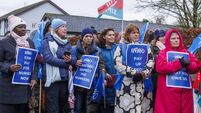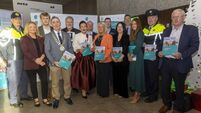Jennings – from ice-cream to eye care

Bernard with his son John, optician
THIS week, I explored the history of the Jennings family, who owned an ice-cream parlour on Castle Street in the 1950s and whose son Bernard and grandson John continue the tradition of business in the centre of Carlow town today.
Bernard’s father Gerald hailed from Ballinrobe, Co Mayo and moved to Carlow in 1939, just before World War II started, to take up a position as an accountant with Corcoran’s Mineral Waters. He stayed with Mrs (Dr) Donoghue in Leinster Crescent. At the time, the population of Carlow town was about 7,000, as opposed to almost 30,000 now, so everybody knew everybody else.
Following an arranged meeting with a lady who was working as a pharmacist in The Curragh, whose name coincidentally was also Jennings, a love affair began, which culminated in marriage in 1948. In 1950, Gerald and Rita Jennings bought 3 Castle Street and opened an ice-cream parlour and confectionery shop.
According to their son Bernard, they had the first whipped ice-cream in Carlow, which was served in large sundae glasses – an exotic post-war treat. People still approach Bernard to this day and tell him how delicious that ice-cream was. When people enquired where Gerald got the money to buy the shop, he proudly declared that he had won most of it playing cards, a very common local pastime of the day.
Four children were born to the Jennings – Oliver, Siobhán, John and Bernard – and the family lived over the shop. With a large family and a business to run, Rita needed help, so Gerald’s sister, who owned a shop in Ballinasloe, sent a young lady to help out for a while. Della Ryan subsequently married Tom Clerkin of the Stonehaven Lounge and remained in Carlow for the rest of her life. In 1960, the Jennings decided to move to Leighlin Road, Graiguecullen and sell the shop. Rita was keen to get back to her profession as a pharmacist. At this stage, 3 Castle Street was sold to Tony Pender, who ran an electrical shop. It now houses the National Council for the Blind charity shop.
Rita worked as a locum in all the pharmacies in town, including Carlow Medical Hall, which was owned by Sam McHugh at 2 Dublin Street where, coincidentally, Bernard has run his optician’s business since 1987. He remembers helping his mother count the takings and the float at the end of the day there after school as he waited for her to go home. Sadly, Rita died suddenly aged 58 in 1979 while working in Athy.
Bernard qualified as an optometrist in 1980 and worked in Dublin for a year before returning to Carlow and setting up his practice at the back of Ruddock’s shop on Tullow Street. Unfortunately, in 1984, Haddens burnt to the ground in one of the biggest fires Carlow has ever seen and Bernard’s optical equipment was completely destroyed with water and smoke damage. For six weeks he had no premises to work from, but then rented 3 Dublin Street, which had been Brennan’s Pork Butchers. After practicing there for two years, number 2 came up for sale and Bernard bought it at auction for £65,000. This building, which was originally the Red Cow Inn, had been recently occupied by Tommy Alcock and was called The Shoe Box.
The premises has 20 rooms and originally had a small garden. Guests of the inn would be able to bring their horses around the side of the building through the gateway which leads to a cobbled yard and let them graze overnight while they stayed there. Having restored the premises, Bernard moved his business from next door, where his son John has now taken over, using state-of-the-art digital technology. Bernard has (kind of) retired, but still visits elderly people at home and in nursing homes to look after their optical needs.
An interesting feature of number 2 is that before it was Carlow Medical Hall it was known as McGrath’s Medical Hall and was owned by the McGrath family, grandparents of Betty O’Gorman of The Wine Tavern across the road. Clare McGrath was an accomplished artist and some beautiful oil-on-wood panels which she painted on the doors of number 2 are still preserved. There is an extensive basement featuring a corbelled archway/tunnel, which may have been a walkway back in the 1700s. Bernard has also preserved an amazing collection of bottles from the period, which would have been used for medicines and lotions.





